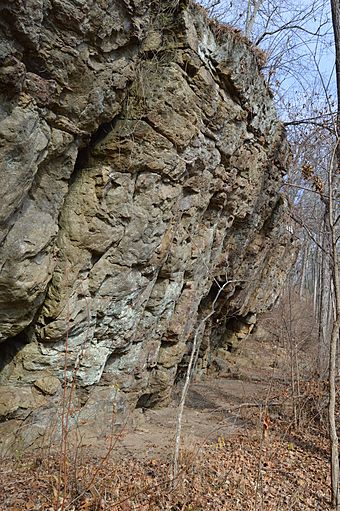Hidden Valley Rockshelter facts for kids
Quick facts for kids |
|
|
Hidden Valley Rock Shelter (44BA31)
|
|

Overview from the western end
|
|
| Lua error in Module:Location_map at line 420: attempt to index field 'wikibase' (a nil value). | |
| Nearest city | Warm Springs, Virginia |
|---|---|
| Area | Less than 1 acre (0.40 ha) |
| NRHP reference No. | 86001945 |
| Added to NRHP | July 22, 1986 |
The Hidden Valley Rockshelter (also known as 44-BA-31) is a very important archaeological site in Virginia, United States. It is a large rockshelter found near the Jackson River in Bath County. People have lived in this shelter for thousands of years, making it a special historic site.
Contents
Exploring the Rockshelter's Location
The Hidden Valley Rockshelter is a tall rock formation with a nearly straight back wall. Trees grow right below its roof. The rock itself is called Oriskany sandstone. It's part of a rock outcrop near the western side of the Jackson River.
How the Rockshelter is Protected from Floods
Even though it's near the river, the shelter is usually safe from floods. This is because it sits about 20 feet (6.1 m) higher than the river's normal water level. The shelter is about 90 feet (27 m) long from one end to the other. From the edge of its roof (the drip line) to the back wall, it's about 10 feet (3.0 m) deep. The shelter has an uneven shape, and you can see vertical lines and deep holes on its back wall.
Discovering Ancient Human Life
Archaeologists know that people have lived in the Hidden Valley Rockshelter for many thousands of years. The way the soil layers are preserved (called stratigraphy) helps scientists understand its long history.
Life in the Rockshelter Through Time
People first lived here during the Late Archaic period, which was about 3,000 years before Christ. Later, people from the Late Woodland period also used the shelter. It was even used into the historic period, which means there is proof that Native Americans and early European settlers met here.
What We Learn from Artifacts
The site is important because of the many different kinds of items found there. Simple artifacts like common projectile points (arrowheads or spear points) and potsherds (broken pieces of pottery) are found everywhere in the midden (a fancy word for an ancient trash heap). The way these items are layered shows how pottery and lithic technology (stone tool making) slowly changed over many generations.
Ancient Environment and Animal Remains
The shelter is special not just for its pottery and stone tools. Plant and animal remains are also very well preserved at Hidden Valley. This helps scientists learn about what the environment was like thousands of years ago.
Unique Burials and Their Meaning
Human remains have also been found at the site. One burial was of a baby less than a year old, found with two dog skulls. The bones of another dog were found mixed with those of a teenage human. Finding dog skeletons might mean the shelter had a special meaning for ancient rituals. Dog burials are known from many Archaic sites, like the Carlston Annis Shell Mound in Kentucky, where almost thirty dogs were buried on purpose. Some experts believe that places where dogs were buried were seen as places of new beginnings. This belief might have continued with the historic Cherokee people.
Protecting This Important Site
In 1986, the Hidden Valley Rockshelter was added to the National Register of Historic Places. This is because it is a very important archaeological site. It is one of twenty-one places in Bath County that have this special recognition. However, the Hidden Valley Rockshelter is unique because it's the only one on the list mainly for its archaeological discoveries.

